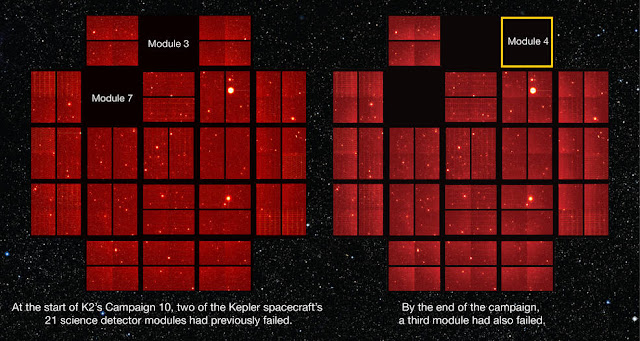The comparison of two full frame images from the
Kepler spacecraft show two black squares (Modules 3 and 7) and 19 red
squares on the left. On the right, there are three black squares
(Modules 3, 4 and 7) and 18 red squares. A red square indicates that
data is being collected by the photometer and a black square indicates
no data is being collected and that the module is no longer functional.
Eighteen of the 21 science detector modules remain fully operational. Credits: NASA Ames/W. Stenzel
Natalie Batalha, astrophysicist and project
scientist for NASA's Kepler Mission at NASA's Ames Research Center in
Silicon Valley.
Jessie Dotson, astrophysicist and project scientist for NASA's K2 Mission at NASA's Ames Research Center in Silicon Valley.
Kepler’s K2 mission is now in the midst of its eleventh campaign,
observing a patch of sky in the direction of the constellation
Sagittarius. During this campaign, it will observe 14,250 new targets,
including the Galactic Center and Saturn's moons Titan and Enceladus.
Campaign 11 began on Sept. 24, but was interrupted for three days
(Oct. 18-20) to make a small pointing correction to accommodate the
imbalance that was created by broadcasting data from a different antenna
on the other side of the spacecraft. Although the spacecraft is as big
and heavy as an SUV, it actually turns slightly when we change the
broadcasting antenna. This is like having your car begin to turn from
the force of the blinking of your turn signal. Yes, the spacecraft is that delicately balanced! Data collection for Campaign 11 will continue until Dec. 7.
Since my last update,
our investigation into the cause of the spacecraft's photometer—the
onboard camera—being powered off in July during Campaign 10, confirms
that that science detector Module 4 failed. The likely cause was a
random part failure that resulted in a high electric current in the
circuitry, which blew the protection fuse, disabling the detector but
preventing the problem from propagating to other detectors. As part of
the fault protection response, the photometer was powered off.
Eighteen of the 21 science detector modules remain fully operational.
Two science modules had failed previously: Module 7 in January 2014 and
Module 3 in January 2010. These are not unexpected events as the
spacecraft ages in the harsh environment of space.
In September, the spacecraft had a unique opportunity to provide a 'wide-angle' view
of comet 67P/Churyumov–Gerasimenko, making observations of its core and
tail. These observations complement the close-in study of the comet
provided by the European Space Agency's Rosetta spacecraft during the
final month of its mission. These and the remainder of Campaign 10 data
have been downlinked to the ground and are being processed for release
at the public archive later this month.
We've also made changes with the Kepler and K2 project scientist personnel. On Aug. 15, Natalie Batalha
was appointed as the project scientist for the Kepler mission. Since
1999, Natalie has served in numerous leadership roles throughout the
mission including deputy principal investigator and science team lead.
In addition to her responsibilities with the Kepler mission, Natalie is a
co-lead of NASA's Nexus for Exoplanet System Science Coalition, and serves on the James Webb Space Telescope Advisory Committee. She also serves as a member of the NASA Advisory Council's Astrophysics Subcommittee, and, in 2013, participated on the task force to define NASA's 30-year Astrophysics Roadmap- Enduring Quests, Daring Visions: NASA Astrophysics in the Next Three Decades.
On Sept. 6, Jessie Dotson
assumed the role of project scientist for the K2 mission. Dr. Dotson
was formerly the deputy science office director for Kepler and, in 2011,
established the Kepler Guest Observer Office.
Most recently, she served as astrophysics branch chief in the Space
Science and Astrobiology Division at NASA Ames. In 2014, Jessie helped
formulate the Asteroid Threat Assessment Project (ATAP) at NASA Ames to
quantify the risk to Earth of an asteroid impact. She currently leads
the ATAP asteroid characterization team. In 2016, Jessie was awarded a
NASA Outstanding Leadership Medal for her work as the astrophysics
branch chief at Ames.
Together, Natalie and Jessie replace Steve Howell who served as
Kepler project scientist since 2010 and K2 project scientist since
mission conception in 2013. In that role, Steve oversaw Kepler science
operations through the end of its prime mission, the recovery from the
reaction wheel failure that nearly ended the mission, and the
development and implementation of the K2 mission that gave Kepler a new
lease on life. We commend Steve for his work as the Kepler/K2 project
scientist, with notable leadership in catalyzing the science community
to support Kepler's extended mission called K2.
In August, the team gathered for the annual year-in-review of
spacecraft operations with Ball Aerospace, the designer, manufacturer
and flight controller of Kepler. A topic of high interest is the
on-board fuel reserve, which is expected to last into the spring of
2018.
At last count, Kepler has identified more than 5,100 planet candidates. Of these, more than 2,500 have been verified as bona fide planets. NASA’s next planet-hunting mission, the Transiting Exoplanet Survey Satellite
(TESS), is scheduled to launch no later than June 2018. TESS will build
upon Kepler’s success and search for exoplanets around the stars
closest to the own solar system.
Regards,
Charlie Sobeck
Kepler and K2 mission manager
NASA's Ames Research Center


